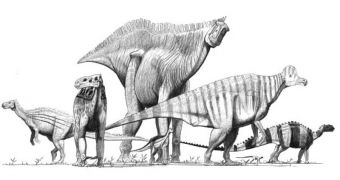According to the results of two years' worth of excellent archeology, experts can now argue that a newly discovered “pocket of life” in Northwestern Alberta, Canada, is a missing link between species that lived further to the North, and others that lived elsewhere in what is now the country. Many fossils were discovered at the location, including those of hatchlings, predators, and various other species that were not identified anywhere else in the area. The experts hypothesize that these conditions could have led to the development of new species, better adapted to this “crowded” environment.
Italian paleontology graduate student Frederico Fanti, working together with University of Alberta (UA) student Tetsuto Miyashita, spent two summers digging up dinosaur fossils from a location near Grande Prairie, located about 450 kilometers Northwest of Edmonton, ScienceDaily reports. In the remains of an ancient nesting site, the investigators discovered the remnants of plant-eating dinosaur eggs, which still had imprinted on them the marks of predators' fangs.
By cross-referencing the bite marks to existing databases, the duo were able to conclude that they belonged to the raptor-like dinosaur Troodon, which was about two meters (six to seven feet) in length. The find “established that dinosaurs were nesting at this high latitude. It also shows for the first time a significant number of Troodons in the area, [that] hunted hatchling dinosaurs,” Miyashita said. “Prior to this there were no localities with a variety of dinosaurs and other animals between Alaska and southern Alberta,” he added about the “missing link” region.
“New dinosaurs weren't created by interbreeding. Having a variety of dinosaurs in one area creates new ecological interactions such as competition for food and predation. That can lead to the evolution of a new species,” the expert explained. Indeed, naturalists agree, when new habitats and ecosystems are formed, the trophic relationships change, and species that were once dominant can themselves come under attack from new predators. Conversely, even the most skilled predator can be driven to extinction if its main source of food moves a few hundred kilometers to the North or to the South.
The team says that new studies are required to fully understand the relationships between the dinosaurs that were found in the fossil pit. As such, they have already planned a new expedition to the region, scheduled to take place in the summer of 2010. The results they've obtained thus far are published in this month's issue of the journal Palaeogeoraphy, Palaeocilmatology, Palaeoecology.

 14 DAY TRIAL //
14 DAY TRIAL //